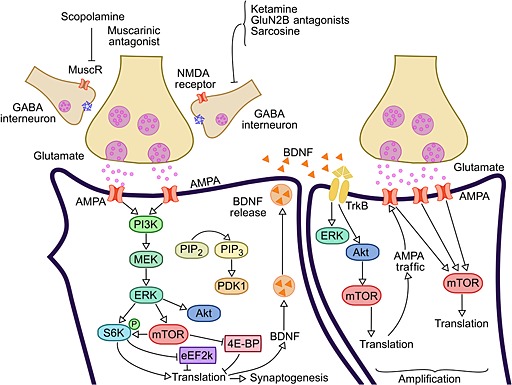Figure 1.

Fast action antidepressants activate mTOR. NMDA and muscarinic receptors antagonists, as well as compounds that act on AMPA receptors activate the mTOR signalling pathway. The activated mTOR triggers a translational machinery, increasing protein synthesis involved with synaptogenesis. Among other synaptogenic molecules, BDNF is released and activates TrkB receptor, whose signalling activates mTOR pathway. Thus, BDNF increases synthesis and traffic of AMPA receptors, thereby increasing their availability and mTOR signalling. This positive feedback loop between AMPA and BDNF seems to be a mechanism involved in the amplification of synaptic plasticity, as well as for the rapid, robust and durable therapeutic antidepressant response. BDNF, brain‐derived neurotrophic factor; mTOR, mammalian target of rapamycin; NMDA, N‐methyl‐daspartate; AMPA, α‐amino‐3‐hydroxyl‐5‐methyl‐4‐isoxazole‐propionate; PI3K, phosphatidylinositol‐3‐kinase; MuscR, muscarinic receptor; ERK, extracellular signal‐regulated kinase; MEK, mitogen‐activated protein kinase; Akt, protein kinase B (PKB); PIP2, phosphatidylinositol biphosphate; PIP3, phosphatidylinositol triphosphate; PDK1, phosphoinositide‐dependent kinase‐1; S6K, ribosomal protein S6 kinase; eEF2K, eukaryotic elongation factor‐2 kinase; 4E‐BP, eukaryotic initiation factor 4E (eIF4E)‐binding proteins
